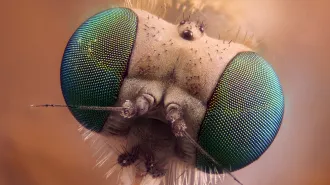- More than 2 years ago
A new method may make it easier to ferret out the health impacts of different bacteria in the intestines. The work could lead to new probiotics, microorganisms that may provide health benefits when consumed, and has already identified a handful of microbes that may contribute to obesity.
Scientists have discovered many links between human health and particular mixes of microbes that live in and on the body. But it hasn’t been easy to pin a health effect on one or a few of the hundreds of different types of intestinal microbes.
“We’ve done this piecemeal,” says Sarkis Mazmanian, a Caltech microbiologist. “It’s slow and cumbersome to do this one organism at a time.” That approach also requires researchers to make educated guesses about which organisms to test.
The new method allows researchers to quickly sift through many different bacteria (or combinations of bacteria) to discover those that produce a particular health effect, such as boosting the immune system, causing weight gain or making substances that promote or prevent diseases. Jeffrey Gordon of Washington University in St. Louis and his colleagues describe the technique January 22 in Science Translational Medicine.
Gordon’s group started with fecal samples from five healthy women. They transplanted the women’s gut bacteria into mice that been raised without any microbes. Compared with bacteria-free rodents, mice with transplanted bacteria produced more immune cells called regulatory T cells, which have been shown to reduce inflammation. The mice with transplants also had slightly thicker fat pads around their gonads — a measure of body fat — than mice with no bacteria did.
The team generated subsets of one of the women’s microbes and found that a collection of 17 bacteria could produce the same effect on the mice as her whole microbial community did. To determine which of the 17 microbes was responsible, the researchers needed to test different microbial blends.
But systematically testing all possible combinations of the bacteria would involve an impractically large number of rodents. For example, testing mixes of five types at a time would require more than 6,000 germ-free mice. Instead, the researchers reasoned that they could randomly create different subsets of the 17 bacteria and see which recipes produced the effect they were looking for. Then they could narrow down the responsible parties by determining which bacteria each of those mixes had in common. Computer simulations combined with mouse experiments eventually led the team to test 94 permutations in 124 mice.
Using the streamlined method, the researchers found that eight types of bacteria increased fat pad size. Adding more than two of these microbes to a mix didn’t make the fat pads grow any further. The microbes studied in these mice came from a lean woman, so the researchers couldn’t directly address microbes that might participate in obesity. They think that obese people may carry additional types of bacteria that can stimulate much more fat production.
Six types of bacteria increased the mice’s production of regulatory T cells, the team found. That number is remarkably high, Mazmanian says. In about 10 years of work, he and other researchers have identified only three or four bacteria that boost numbers of the immune cells. But he doesn’t doubt the finding: “The data are rock solid. I’m just surprised at how many they found.”
The computer software the team developed will also help researchers decipher how microbes interact, says study coauthor Philip Ahern of Washington University in St. Louis.
He and coauthor Jeremiah Faith, now at the Icahn School of Medicine at Mount Sinai in New York, developed special cages with air filters to house mice in a sterile environment. Without the special cages, each mouse carrying a particular mishmash of microbes would need its own plastic incubator to prevent the animals from contaminating each other and the germ-free rodents. The filtered cages greatly increased the number of microbe mixes the researchers could test, Gordon says.
Most academic labs aren’t equipped to handle the large number of bacteria-free mice needed to conduct the experiments, Mazmanian says. Still, companies could use the technique to identify possible probiotics.






